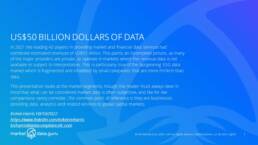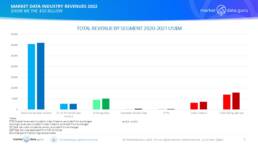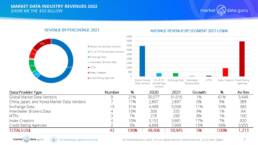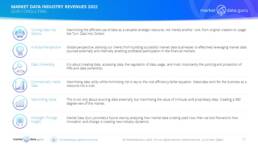
MEASURING THE MARKET DATA MARKET
In 2021 the leading 42 players in providing market data services had combined estimated revenues of US$50.94 Billion up 5% from US$48.41 Billion in 2020. It must be noted the figures excludes major companies that are either not listed like ION Trading or are building significant data businesses like Broadridge, therefore the market size needs to be reviewed in context.
We can divide the market into 7 segments:
1.Global Market data vendors
2.China and Japan market data vendors
3.Exchange data
4.inter-dealer brokers
5.MTFs/ATS
6.Index creators
7.Credit rating agencies
Significant variances can be identified. For instance, categorising specific companies is simplistic because market data vendors also have their own trading venues, indices and other services, plus there is increasing competitive overlap between companies across the segments.
The ESG market is increasing rapidly with a plethora of small players, however the largest 3 can be counted firmly within the categories above, MSCI, ISS (majority owned by DBAG) and Sustainalytics, now a Morningstar subsidiary
THE ROAD TO $50 BILLION
Data saturation is an issue that impacts growth, not in terms of quantity, there are mind boggling amounts of data constantly being churned out, but closer examination reveals it includes only limited amounts of new original raw data. The money is all in what you can do with that data.
Exchanges are getting the message. Leaders like ICE, and the LSE recognised early on it is not only about the data per se, but what the users do with it. The luxury of large active markets have given the big exchanges a head start their smaller brethren can only dream about, by expanding rapidly into the value-added data world
An area of convergence is by adding value to original price data, i.e. creation of new data, like indices, or providing analytical services. Taking raw data, building actionable insights, investment decision tools, and performance benchmarks
KEY POINTS
- Top 9 Market Data Vendors account for 61% of market spend, US$31.016 Billion, when excluding their index & CRA businesses
- The Far East, China, Japan, and Korea market data vendors have estimated revenues of US$2.697 Billion, however Covid has had a major impact. Diversification by Chinese market data vendors into offering trading and brokerage services built around their data portends the future of businesses like TradingView
- The market potential for vanilla raw price data is limited by the number of vendors and investing institutions, which explains to a small degree why exchanges, IDBs and MTS share just 12%, of the total market by value, US$5.64 Billion, yet account for 48% of the 42 suppliers
- All exchanges saw revenue growth over the period, the large exchanges often through acquisition. While smaller exchanges relied upon price increases, something we believe to be unsustainable in the market place over the next 12 to 24 months
- The 4 index creators and 2 credit rating agencies (figures for Fitch Ratings are unavailable), original works creators where data IP and licences transition from source to new works account for 23% of total revenues, US$11.59 Billion (S&P is divided into separate Index & CRA entities)
- Creating value around data usage has supplanted the delivery of vanilla data products and services

TAKEAWAYS
- In 2021 the average revenue of market data vendors was US$3.446 Billion, but this is skewed by the size of Bloomberg and Refinitiv, and the omission of a multitude of vendors in the sub US$1 Billion pa revenue space
- Most exchanges still make most of their money from vanilla price data services, and once FTSE Russell, Quontigo, ICE Data Services are placed in their individual categories the average revenue is US$385 Million in 2021. A major issue is they are reliant upon Bloomberg and Refinitiv either directly or indirectly for 60%+ of income
- Inter-Dealer Brokers are unsurprisingly the smallest segment, with only 1% of the total market data revenues with an average of US$84 Million, however as a segment when added to OTC trading venues (ATS/MTF) offer exciting potential
- Equally unsurprising is the success of the index creators with an average revenue of US$920 Million, driven by the growth in passive funds, the need for benchmarks, and opening up of OTC indices, and the rise of a new breed of index creators
- The second highest average revenue segment, are the Credit Rating Agencies, US$3,955 Billion, with only 3 truly global agencies and effectively a closed shop, this is arguably the most profitable market data business to be in, however the average figures are only for Moodys and S&P as accurate revenue data for Fitch is unavailable

TRENDS
Too often market data gets looked at in isolation from the financial markets which drive its production and which it serves, so it becomes too easy to miss the key trends that are occurring and only increasing the process of change, for instance:
1.An emphasis on data that is produced by automated trading and systems
2.The continued growth of automated usage, which in turn generates even more data
3.This is driven primarily by analytics, in the pre and post trade
4.Analytics work by processing events, i.e. historical data. This was once regarded as low value, yet now, historic and especially historical trading data is fast moving to the top of the data food chain
5.The increasing creation of new IP in the form of benchmarks, evaluated pricing, and ratings
Too many data providers in the market data industry are yet to recognise the key trends that impact them, or adapt strategies where they can take advantage of the new opportunities opening up.
FINAL THOUGHTS
A MALAISE
- A tiny 5% (admittedly over only 1 year) increase in overall revenues seems to indicate malaise, yet hides the plethora of new specialist data providers springing up, and the willingness of both vendors and exchanges to buy them
- There is data saturation in the leading financial institutions, the number of terminals on desks are at best static, and the demand for datafeeds needed are more the product of competition than growth
- There is danger in market data suppliers competing for a greater share of an existing pie instead of baking a bigger pie
A RENAISSANCE
- Yet the 42 listed does not encompass the myriad of smaller and innovative companies that exist and are springing up
- It ignores the growth in new IP which is expanding from a lower base than the traditional market data vendors
- Appearing are new types of market data players, the data malls, third party processors and facilitators which are changing the face of market data workflows, such as,
- FinTechs in the Wealth Management space, RegTechs need data to function, none of which has yet to be truly exploited
- Finally the market data industry has become so wedded to financial institutions (understandably) it finds it difficult to embrace a new era of untapped larger markets, i.e. the mass media, HNWI, and retail, both philosophically or by developing business models able to take advantage of these opportunities
Keiren Harris 10 October 2022
Please contact info@marketdata.guru for a pdf copy of the article
For information on our consulting services please email knharris@datacompliancellc.com


